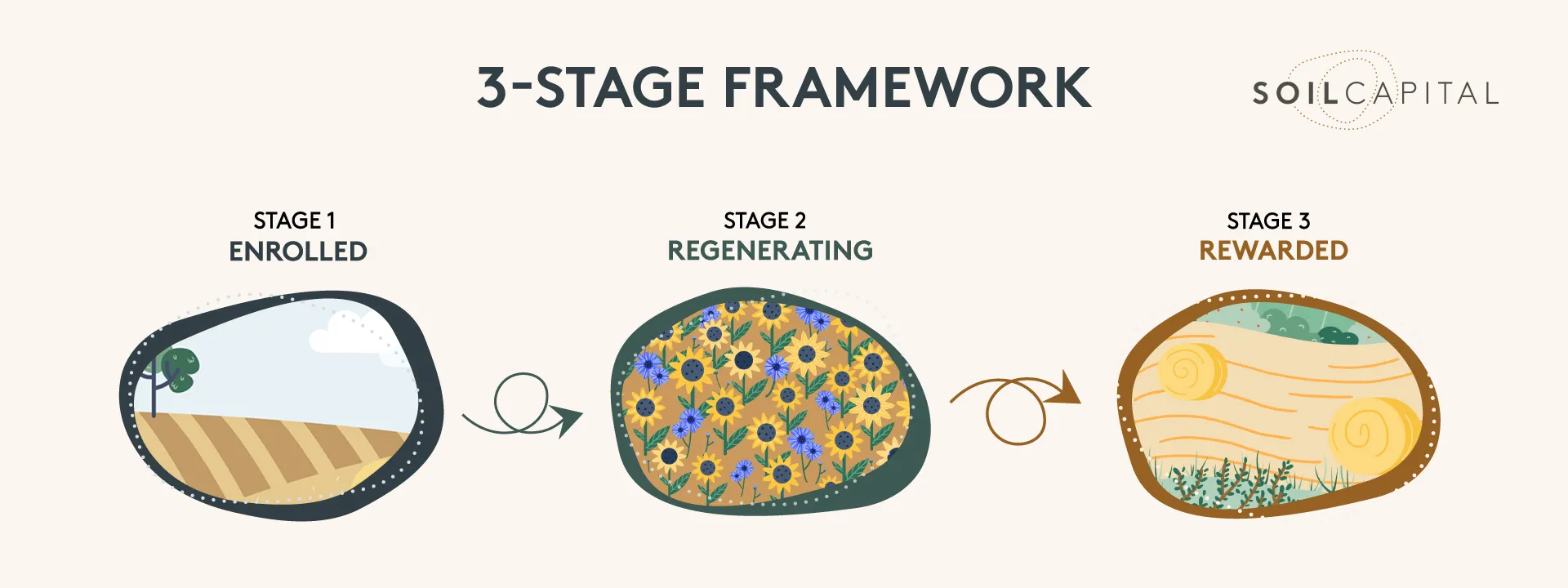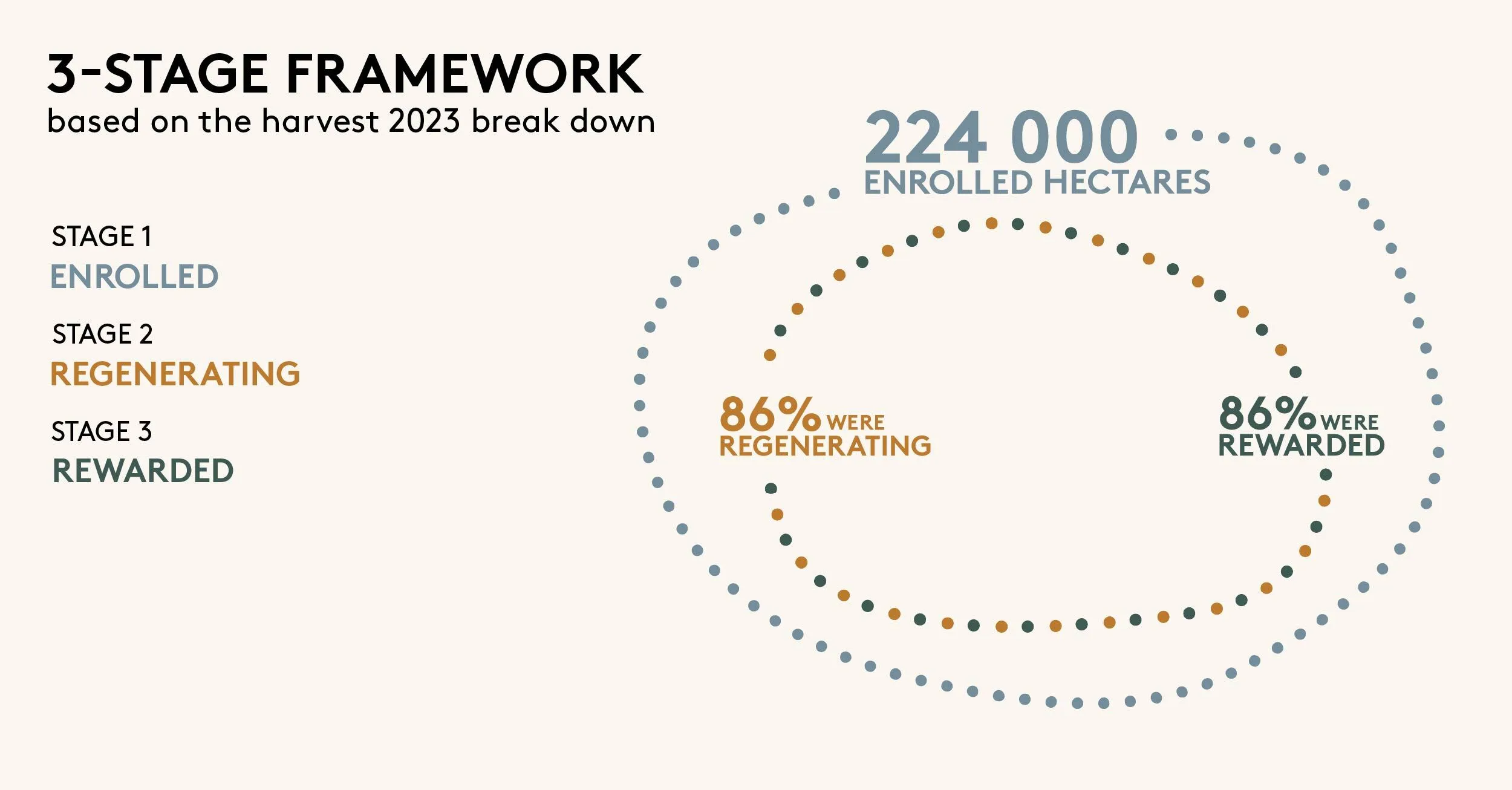





At Soil Capital, we often think about the right metrics to track not only our performance but also the progress of regenerative agriculture as a movement. Our mission is clear: to support farmers in regenerating as many hectares as possible, as quickly as possible, to combat environmental degradation, build the resilience of the food system and improve farmer livelihoods. However, the landscape is often clouded by confusion over business models, theories of change, and evaluation frameworks.
To cut through this complexity, we’ve developed a practical system to measure the performance of regenerative programmes in a way that resonates with our stakeholders—corporate clients, investors, employees, and most importantly, farmers. Over the past year, this system has become central to how we operate, and we believe it offers valuable insights that can be shared across the industry.
In our daily work, we address three interdependent challenges:
Getting farmers to sign up for our regenerative agriculture programme is the first step. Achieving this at scale requires more than just marketing,, This is essentially - not to say only - an exercise in building trust and demonstrating value over the long term.
Post enrollment, the hard part is to create the conditions for farmers to adopt and maintain regenerative practices. This is where the real - i.e. agronomy focused - transformation begins, as farmers make the shift toward regenerative agriculture.
Farmers rightfully expect compensation for their environmental efforts, for the risks they take when changing practices, to deliver a service that has value for their immediate partners as well as for society at large. So a key piece of a regenerative programme consists in securing the necessary revenue to pay them, typically by engaging with offtakers. These offtakers can be public or private, within or outside the AgFood value chain. In Soil Capital’s case we mostly engage with companies that purchase the farmers' crops and seek to build resilient supply chains and reduce their scope 3 emissions from agriculture.
To effectively measure our progress toward these goals, we’ve developed the Enrolled-Regenerating-Rewarded (3-stage) system. This framework allows us to quantify our work in a clear and structured way, breaking it down into three stages:
Enrolled Hectare: A hectare is considered "Enrolled" once a farmer registers it in our regenerative agriculture programme. This means the farmer has agreed to our terms and conditions and has committed to participating in our initiative. At this stage, the farmer has made a commitment to change but has not yet begun to implement regenerative practices.
Regenerating Hectare: The hectare starts "Regenerating" when the farmer actually starts adopting regenerative practices (meaning cover cropping, reduction of land disturbance, organic fertilisation, crop diversification or agroforestry). A farmer is considered “regenerating” after a cropping season has been certified and the regenerative practices have been registered.
Rewarded Hectare: Finally, a hectare is "Rewarded" when we have secured the revenue necessary to compensate the farmer. At Soil Capital, this happens when we sign a contract with an offtaker who agrees to pay for the farmer's environmental services, thereby ensuring the farmer's efforts are financially rewarded. This ensures a couple of important things: it creates the signal for existing farmers in the programme to maintain their transition efforts and provides the credible incentive for new farmers to join the programme.
To illustrate how this framework works in practice, let's look at our programme for the latest fiscal year. Here’s how the hectares in our programme based on the harvest 2023 break down.

Concretely, this means two things. One, the overwhelming majority of farmers coming into the programme actually adopt regenerative practices. Two, all of these farmers have been financially rewarded by a Soil Capital payment.
This breakdown not only helps us track progress but also ensures we remain focused on driving real change on the ground.
We value the 3-stage system for several reasons:
Finally, we appreciate the 3-stage framework because it aligns our business performance with the impact we seek: to reward farmers for the regenerative change they deliver.
The 3-stage framework offers a comprehensive view of our efforts and serves as a stepping stone for broader industry discussions. By sharing this framework, we hope to contribute to a wider conversation about delivering true regenerative impact at scale. Whether you are a farmer, a corporate buyer of environmental services, an investor or even a policy maker, we invite you to explore how the 3-stage system can be adapted to your own regenerative initiatives and look forward to your feedback and collaboration in this ongoing journey.


At Soil Capital, we often think about the right metrics to track not only our performance but also the progress of regenerative agriculture as a movement. Our mission is clear: to support farmers in regenerating as many hectares as possible, as quickly as possible, to combat environmental degradation, build the resilience of the food system and improve farmer livelihoods. However, the landscape is often clouded by confusion over business models, theories of change, and evaluation frameworks.
To cut through this complexity, we’ve developed a practical system to measure the performance of regenerative programmes in a way that resonates with our stakeholders—corporate clients, investors, employees, and most importantly, farmers. Over the past year, this system has become central to how we operate, and we believe it offers valuable insights that can be shared across the industry.
In our daily work, we address three interdependent challenges:
Getting farmers to sign up for our regenerative agriculture programme is the first step. Achieving this at scale requires more than just marketing,, This is essentially - not to say only - an exercise in building trust and demonstrating value over the long term.
Post enrollment, the hard part is to create the conditions for farmers to adopt and maintain regenerative practices. This is where the real - i.e. agronomy focused - transformation begins, as farmers make the shift toward regenerative agriculture.
Farmers rightfully expect compensation for their environmental efforts, for the risks they take when changing practices, to deliver a service that has value for their immediate partners as well as for society at large. So a key piece of a regenerative programme consists in securing the necessary revenue to pay them, typically by engaging with offtakers. These offtakers can be public or private, within or outside the AgFood value chain. In Soil Capital’s case we mostly engage with companies that purchase the farmers' crops and seek to build resilient supply chains and reduce their scope 3 emissions from agriculture.
To effectively measure our progress toward these goals, we’ve developed the Enrolled-Regenerating-Rewarded (3-stage) system. This framework allows us to quantify our work in a clear and structured way, breaking it down into three stages:
Enrolled Hectare: A hectare is considered "Enrolled" once a farmer registers it in our regenerative agriculture programme. This means the farmer has agreed to our terms and conditions and has committed to participating in our initiative. At this stage, the farmer has made a commitment to change but has not yet begun to implement regenerative practices.
Regenerating Hectare: The hectare starts "Regenerating" when the farmer actually starts adopting regenerative practices (meaning cover cropping, reduction of land disturbance, organic fertilisation, crop diversification or agroforestry). A farmer is considered “regenerating” after a cropping season has been certified and the regenerative practices have been registered.
Rewarded Hectare: Finally, a hectare is "Rewarded" when we have secured the revenue necessary to compensate the farmer. At Soil Capital, this happens when we sign a contract with an offtaker who agrees to pay for the farmer's environmental services, thereby ensuring the farmer's efforts are financially rewarded. This ensures a couple of important things: it creates the signal for existing farmers in the programme to maintain their transition efforts and provides the credible incentive for new farmers to join the programme.
To illustrate how this framework works in practice, let's look at our programme for the latest fiscal year. Here’s how the hectares in our programme based on the harvest 2023 break down.

Concretely, this means two things. One, the overwhelming majority of farmers coming into the programme actually adopt regenerative practices. Two, all of these farmers have been financially rewarded by a Soil Capital payment.
This breakdown not only helps us track progress but also ensures we remain focused on driving real change on the ground.
We value the 3-stage system for several reasons:
Finally, we appreciate the 3-stage framework because it aligns our business performance with the impact we seek: to reward farmers for the regenerative change they deliver.
The 3-stage framework offers a comprehensive view of our efforts and serves as a stepping stone for broader industry discussions. By sharing this framework, we hope to contribute to a wider conversation about delivering true regenerative impact at scale. Whether you are a farmer, a corporate buyer of environmental services, an investor or even a policy maker, we invite you to explore how the 3-stage system can be adapted to your own regenerative initiatives and look forward to your feedback and collaboration in this ongoing journey.
